
FS-1077 | October 2018
Food Safety in Your School Gardens, Classrooms, and Greenhouses
Keep the School Gardening Environment Healthy by Following Good Agricultural Practices
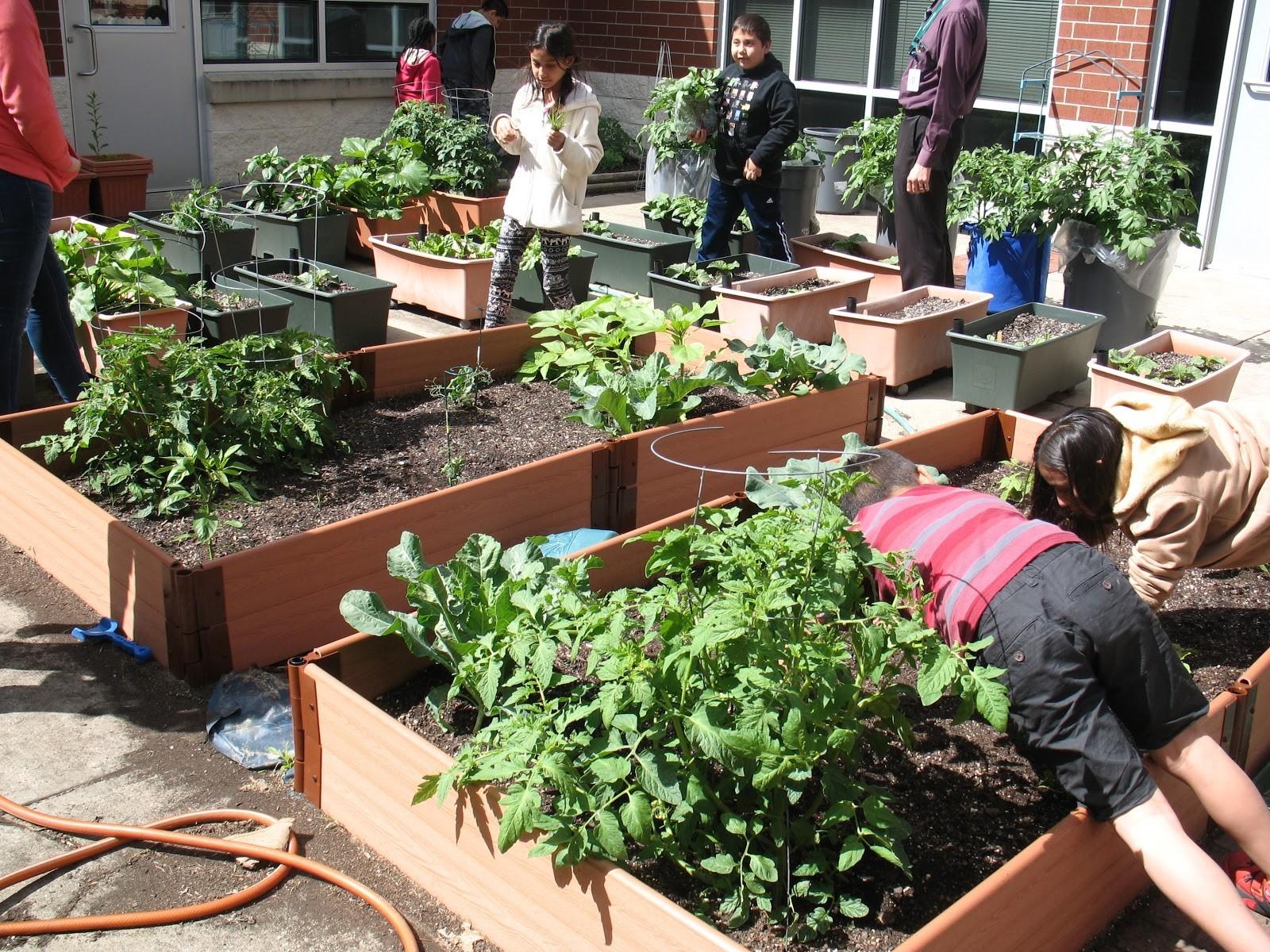
School gardens and greenhouses are excellent environments for teaching students about agriculture, horticulture, sustainability, nutrition, and linking educational concepts in math, English language arts, social studies, health, and science. To keep teachers and students healthy while working in school gardens and greenhouses, it is important to know about possible risks and how to prevent them, which will keep your garden and greenhouse healthy too!
Microorganisms are all around us and most are beneficial for helping fight off illnesses and other processes in nature. However, there are some microorganisms (germs) that can make us sick. Through safe practices, you can reduce the spread of germs.
The purpose of this fact sheet is to educate school staff, faculty, parents, and students about Good Agricultural Practices (GAPs) that can decrease the risk of germs contaminating produce grown in school gardens, classrooms, and greenhouses. Fruit and vegetable growers have been following the national GAP program since its inception in 1998 to improve food safety on their farms. Follow the steps below to ensure that your school garden or greenhouse is managed in a way that provides a safe working and learning environment, as well as safe produce for consumption.
Choose the Location of Your Garden Carefully
When selecting the site for your school garden, consider the following:
- Make sure your garden isn’t located near a well, septic system, in-ground tank, or dumpster.
- Locate your garden (including container gardens) on level ground and at least four feet away from buildings. Check with your school, district, and/or county for other rules.
- Avoid low-lying areas where water can collect. Vegetables grow better in well-drained soils.
- Avoid damaging underground pipes and wires by contacting “Miss Utility” at 1-800-257-7777.
Safe Gardening Starts from the Ground Up so Test Your Soil
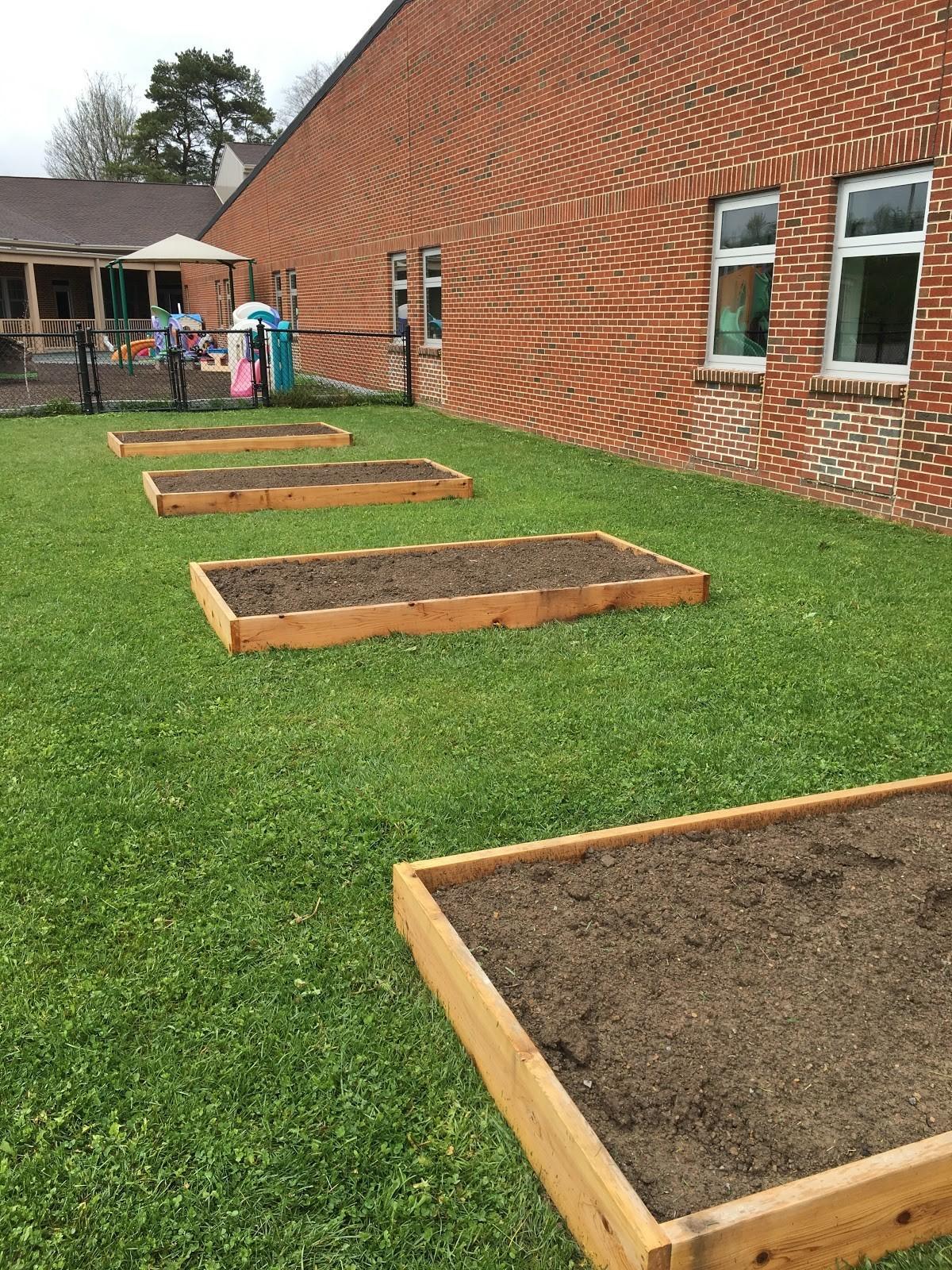
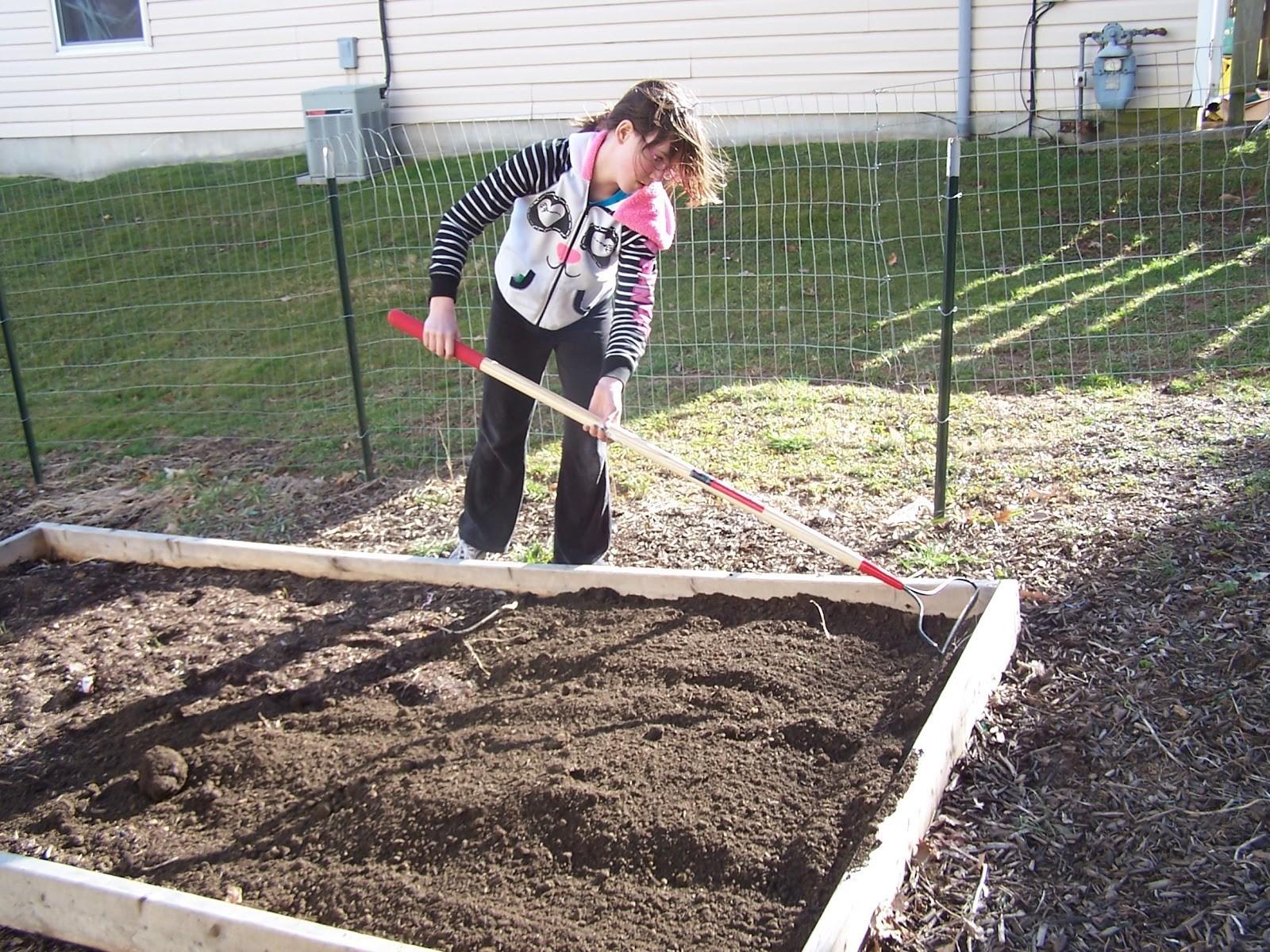
Soils may contain high lead levels, which can be particularly harmful to children. The greatest risk for exposure in a garden can occur when contaminated soil dust is inhaled, contaminated soil is ingested, or when soil particles containing lead adhere to garden produce that is later consumed.
All soils will have a natural lead level of less than 40 parts per million (ppm). Soil with a lead level below 400 ppm is safe for in-ground gardens, but use purchased top soil and compost for raised beds if the soil lead level is between 400 and 1200 ppm. Do not locate school gardens in areas with a soil lead level above 1200 ppm.
Private and university labs can evaluate soil lead levels. Purchasing commercial soil in bags rather than in bulk or accepting donations can reduce risk and improve traceability.
| Soil Lead Level | Recommended Use |
|---|---|
| <40 ppm | Natural level of lead in soil. Safe for in-ground school gardens. |
| 40-400 ppm | Elevated soil lead level. Safe for in-ground school gardens. |
| 401-1200 ppm | Elevated soil lead level. Not safe for in-ground school gardens. Raised bed with purchased topsoil and compost recommended. |
| >1200 ppm | Elevated soil lead level. Not safe for in-ground school gardens. Raised bed with purchased topsoil and compost recommended. Completely cover exposed soil with a groundcover or mulch. |
Use lightweight, soilless growing media (potting soil) for container gardens. These commercial products typically contain peat moss, coconut husk fibers (coir), bark fines, compost, perlite, and vermiculite. They also have a small amount of fertilizer that will provide nutrients for 4-8 weeks. You can use only a soilless potting mix or add compost to boost plant growth.
Do not fill containers with soil, even if it’s high-quality garden soil. Soil particles and pore spaces are much smaller than soilless growing mix. Therefore, water will drain too slowly through soil and roots will suffer from a lack of oxygen, reducing plant growth. Fill raised beds with a mixture of compost and garden soil (or purchased topsoil) in a 1:2 or 1:1 ratio.
Check with Your School and/or District Regarding any Food Safety Regulations
These regulations set specific guidelines for areas of concern such as composting, water quality, animals, and post-harvest procedures. The U.S Department of Agriculture (USDA) GAP and Maryland Department of Agriculture (MDA) GAP programs are helpful resources. Follow this link https://mda.maryland.gov/foodfeedquality/Pages/good_ag_practices.aspx for more information.
Lessons Should Include Instructions to Keep Students Safe While Working in the Garden
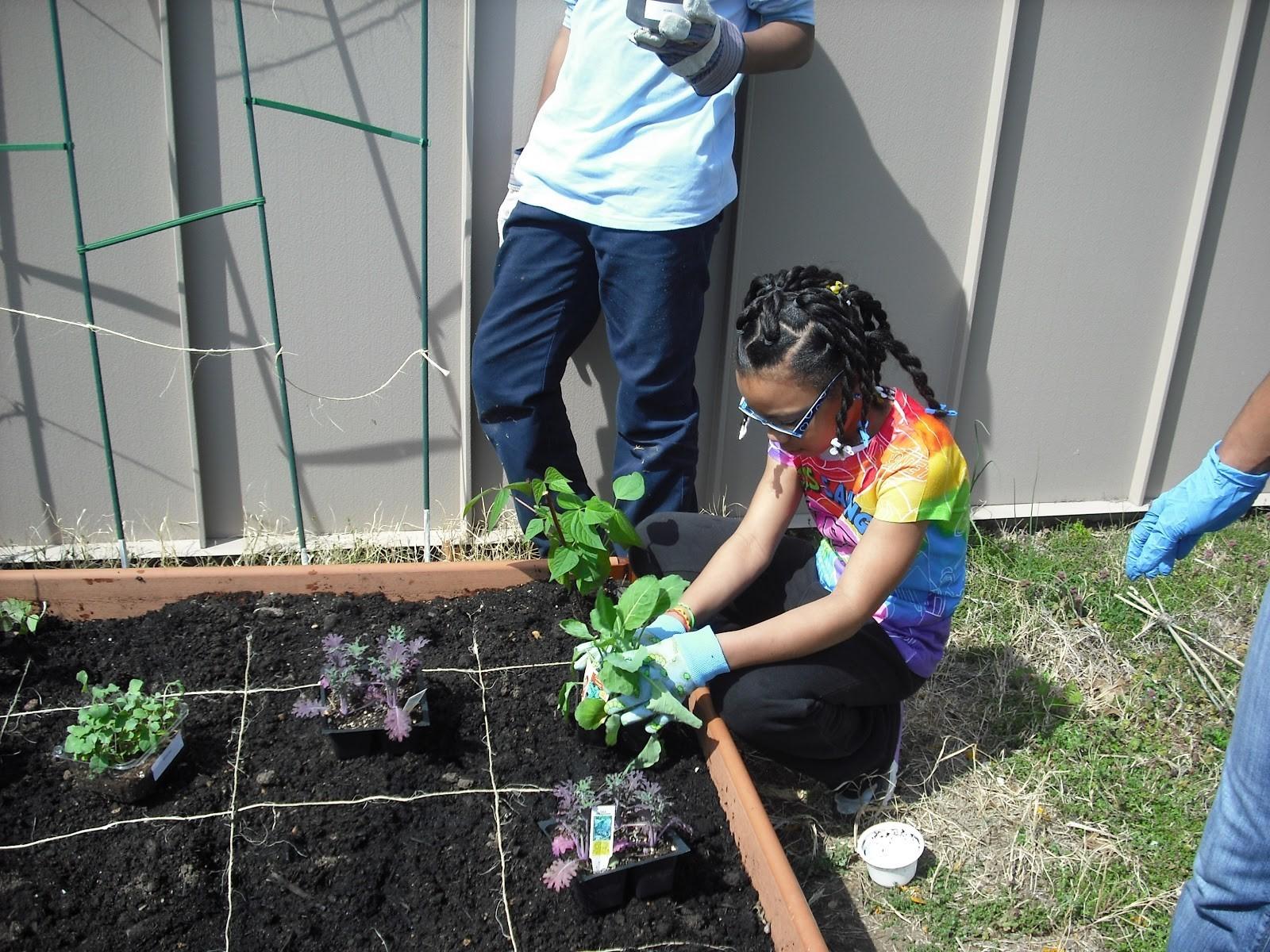
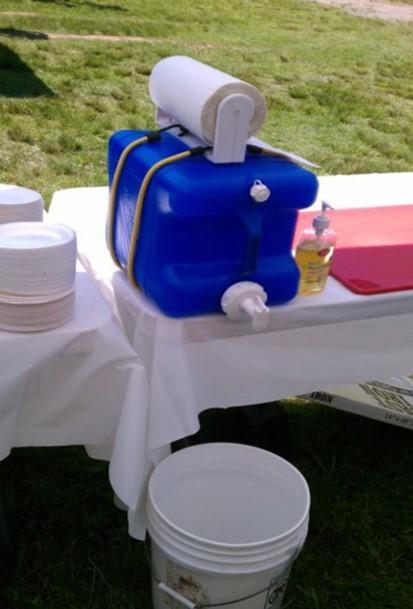
School gardens and greenhouses provide an excellent teaching environment, but students need to follow safety instructions. As a rule, students should not eat anything in the garden until it has been thoroughly washed.
Students must wear closed-toe shoes to protect their feet from cuts and stings. You should not allow students to garden in bare feet, sandals, or flip flops. Encourage students to wear hats while gardening, and to apply sunscreen to exposed skin if they expect to be in the garden for more than 15 minutes. Make students aware that exposure to the sap, leaves, and stems of certain plants (such as squash or tomatoes) can cause mild skin irritation or contact dermatitis in sensitive individuals.
Provide a shaded area for students to rest and eat snacks and meals. Make sure that students wash their hands thoroughly before eating. To encourage handwashing, simple handwashing stations can be set up on site (see image). All that is required of a handwashing station is potable (safe to drink) water, soap, single-use paper towels, and receptacles for collecting used water and paper towels. Hand sanitizer should not be used in place of hand soap. Teach students to lather for at least 20 seconds by singing the “Happy Birthday” song twice and to scrub under fingernails. For more information about handwashing, see https://www.cdc.gov/handwashing/index.html
Consider having all parents sign permission slips that list potential hazards and that allow students to work in the garden. The school nurse and teacher should have a record of all the students’ allergies, including food and insects. You should have a first aid kit and drinking water available to students.
Educate Students on Proper and Safe Use of Tools and Materials
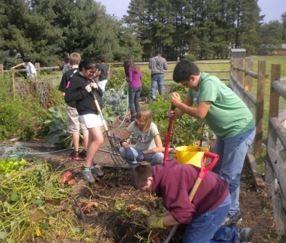
Closely monitor students using sharp tools such as spades, trowels, clippers, and scissors. Identify and explain which tools are for adult use only. Tool use by adults and students will vary from school to school.
Instruct students using tools to stay an arm’s length plus the tool length away from the next person. Students should not hold tools above waist level. Instruct them not to run or play around while holding tools. Lean all long-handle tools against a wall or fence when not in use. Never lay a metal rake on the ground. Monitor the garden for tripping hazards, especially tools and hoses. Post tool safety reminders where students will see them often such as tool shed doors.
Gardening materials such as potting soil, lime, and fertilizer should be handled with care. In general, teachers and adult volunteers should handle these materials; older students or students who are trained in proper usage may also handle them. Potting soil can be dusty when it is applied to container gardens. Wearing a dust mask can protect users. Alternatively, wetting the potting soil prior to use can prevent the spread of dust. If the potting soil is wet, students in elementary school or older may handle it. Use of dry potting soil should be limited to middle school students and older. While lime can be handled by middle and high school students, fertilizers should only be handled by adults or trained high school students. Make sure students understand what gardening materials they are allowed to handle, and which are off limits.
It’s Important to Know What Should go into Your Compost Pile
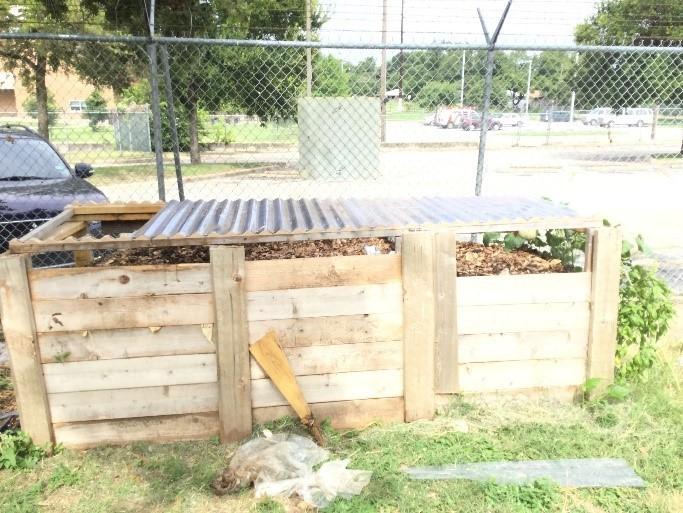
Consider using green waste like leaves or grass and flower clippings. Do not add diseased or insect-infested plant material to compost to avoid the risk of spreading the disease or insects to new plant material when you apply the compost. Do not use manure, pet waste, or food scraps, as these can contain harmful germs. Avoid any green waste that’s been treated with pesticides (including herbicides). It is important to wear gloves when handling compost. Wash your hands after handling. Commercially-produced compost made from manure is safe if it is bagged and certified by the Maryland Department of Agriculture (MDA). Contact your local extension office www.extension.umd.edu or Ask an Expert (extension.umd.edu/ask).
Know the Quality of the Water Source for the Garden or Greenhouse
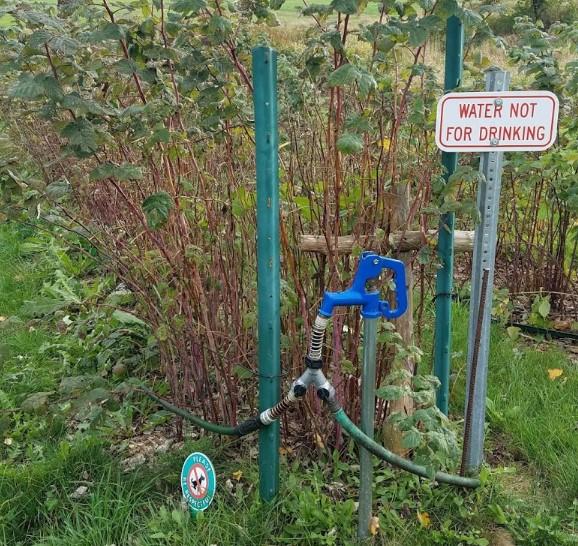
Testing water for lead is required for all Maryland elementary schools and schools built before 1988, but we recommend that all schools test their water.
Some garden hoses contain lead in their lining, so you should run the hose for 2 to 5 minutes away from the garden. You can purchase food-grade hoses that are free of lead. Bacteria love to live and grow inside of hoses where it is dark, damp, and warm. Therefore, it is important to discourage bacteria and small animals from going inside by storing hoses off the ground. This will also help protect them from lead contamination if soil lead levels are high, eliminate a tripping hazard, and extend hose life.
Check with the school administrator to determine if your school follows a specific water standard. Most schools use municipal water that is potable, but if you are going to use other sources such as a well, pond, or rain barrel water, test the water for human pathogens (total coliforms and generic E. coli). Private laboratories can test water samples that you collect and drop off or mail in or they can collect the sample for you. A list of laboratories is available on the MDA website https://mda.maryland.gov/foodfeedquality/Pages/good_ag_practices.aspx
Rain Barrels Provide a Lesson in Sustainability but Should not be Used in Edible Gardens
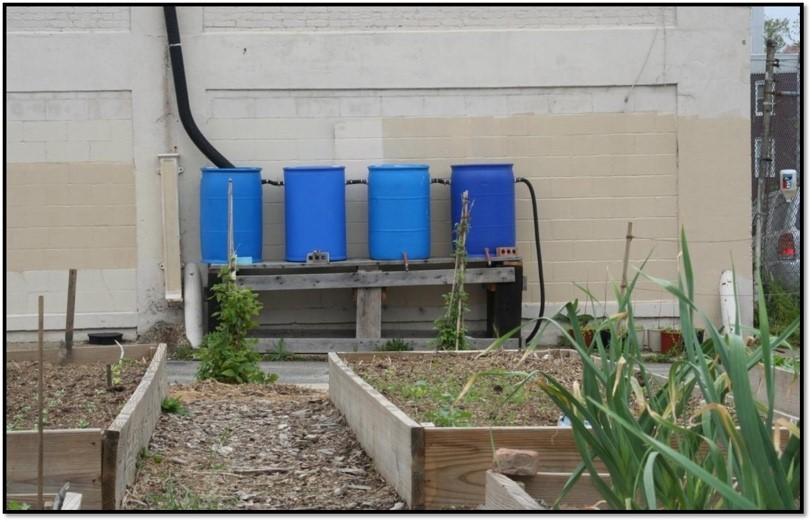
Educating students about the water cycle and water conservation is important. In a school garden setting, installing rain barrels can be an excellent way to do that. If you are thinking of using rain barrels, add a food safety component to your planning process. Most water entering rain barrels comes into contact with roofs and gutters, which are open to wildlife flying overhead and air pollution. As a result, these surfaces may be contaminated with harmful germs and heavy metals. We recommend using rain barrel water for irrigating ornamental (non-edible) gardens but not edible gardens.
Learn about Integrated Pest Management to Eliminate Pests without Using Chemicals
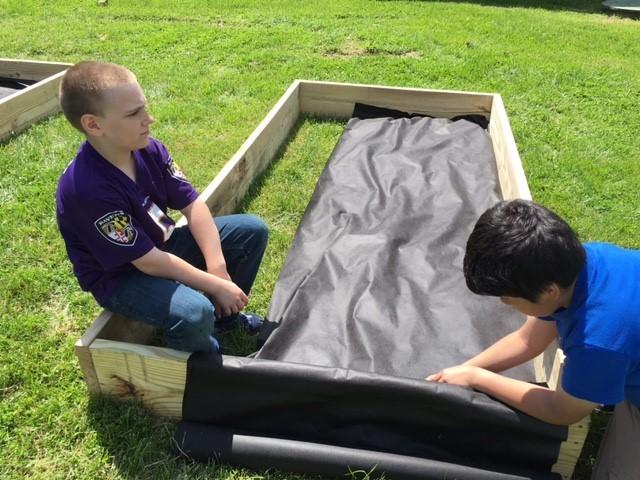
There are hundreds of species of insects living naturally on school grounds, above and below the soil. The vast majority are benign or beneficial (e.g., they pollinate crops or feed on insect pests). You can manage others that injure vegetable crops by removing pests by hand or using other non-chemical techniques.
Weeds compete with garden plants for water and nutrients and can harbor some insect pests and diseases of vegetable crops. You can control weeds by using mulches, hand-pulling, and weeding implements but not herbicides. Do not use pesticides (synthetic, organic, or homemade) in school gardens or greenhouses. Only licensed applicators can legally apply pesticides on public grounds.
Diseases, poor soil conditions, unusual weather, and many other living and nonliving factors cause other plant problems. These and other garden setbacks can serve as positive learning experiences by exploring the possible causes and the web of ecological relationships behind garden phenomena. We recommend that you practice Integrated Pest Management (IPM), a holistic approach to garden problem solving. To learn how to identify and manage insect pests, beneficial insects, plant diseases and weeds, visit the University of Maryland Extension’s Home & Garden Information Center website https://extension.umd.edu/hgic
Fences Make for Good Wildlife Neighbors
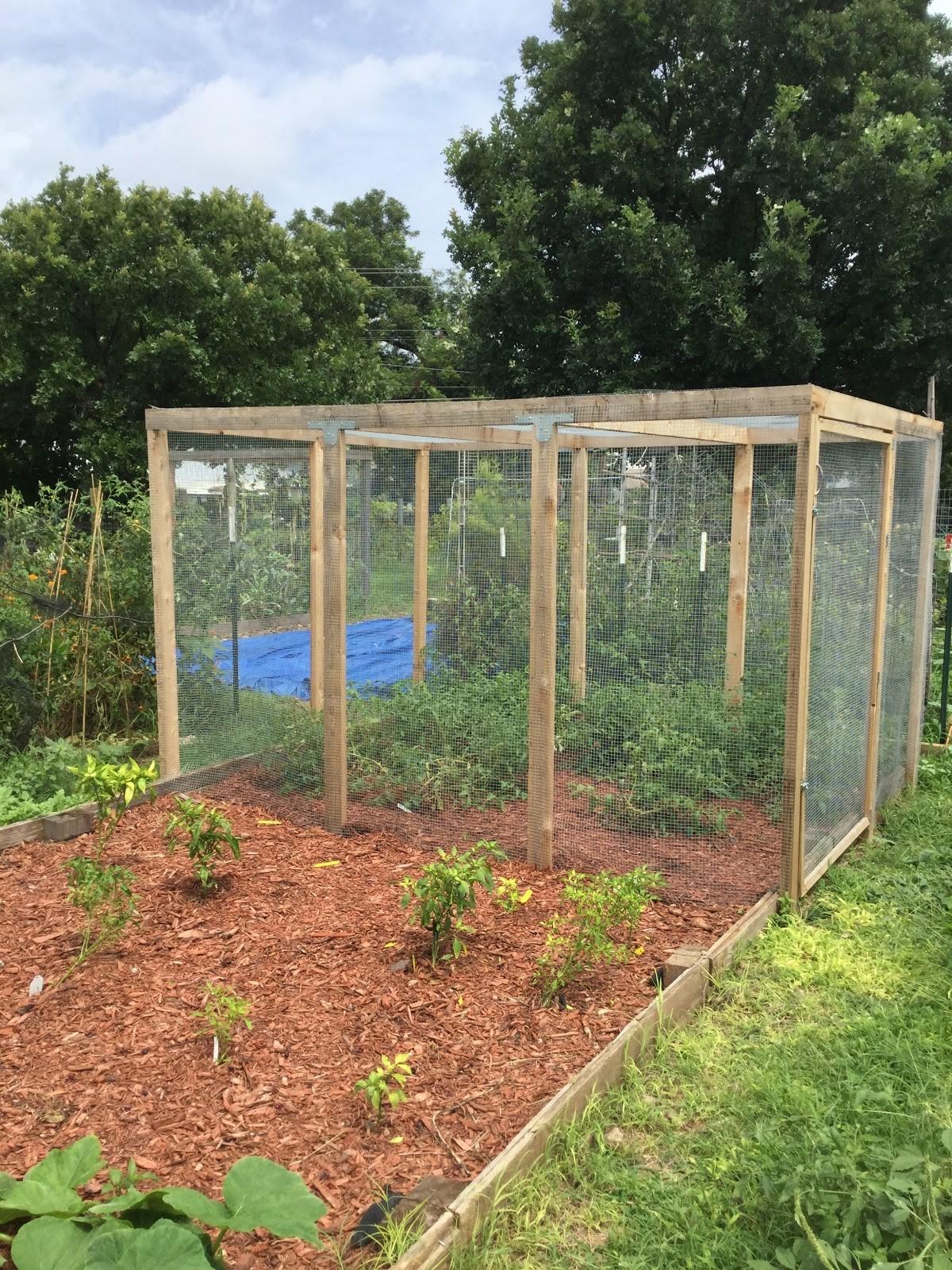
If deer, rabbits, groundhogs, etc. are disturbing your garden, consider obtaining permission, funding, and assistance to build a fence with a gate around your garden. If deer are the problem, the fence will need to be at least 8 ft. tall. A 4 ft. fence is adequate for keeping out smaller animals. Not only will a fence stop animals from eating your vegetables, it will also prevent animal droppings from coming into contact with your food. Ask your school, district, and/or county about rules regarding fencing.
Reduce nesting and hiding places for rats and mice by keeping the grass mowed in and around your garden, especially around fencing. Cover the tops of stakes and posts to keep birds from resting and leaving droppings in and around your garden. Do not put birdfeeders, birdhouses, and/or bat houses near or in school gardens. In general, good housekeeping around the garden and greenhouse, such as regular harvesting and cleanup will prevent rotting produce in the garden and attract fewer pests.
Simple Measures Will Help Reduce Greenhouse Pests
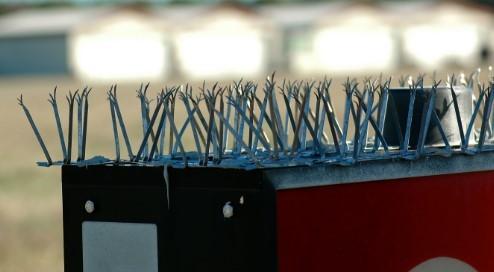
Keep doors closed as much as possible to prevent birds from getting inside greenhouses. Seal cracks in walls or along baseboards. Reduce roosting by attaching spikes or other objects to exposed rafters.
Limit rodent nesting and hiding places by keeping floors clean around plants and/or keeping plants on pallets or tables. Rodents prefer to move along walls. Keeping shelves and tables several inches away from walls will give rodents a clear path to move and reduce their contact with plant material and/or tools. Keeping plants and tools off the floor and away from walls will also make it easier to look out for pests and their droppings.
Chickens Should not be Allowed Near or in Gardens
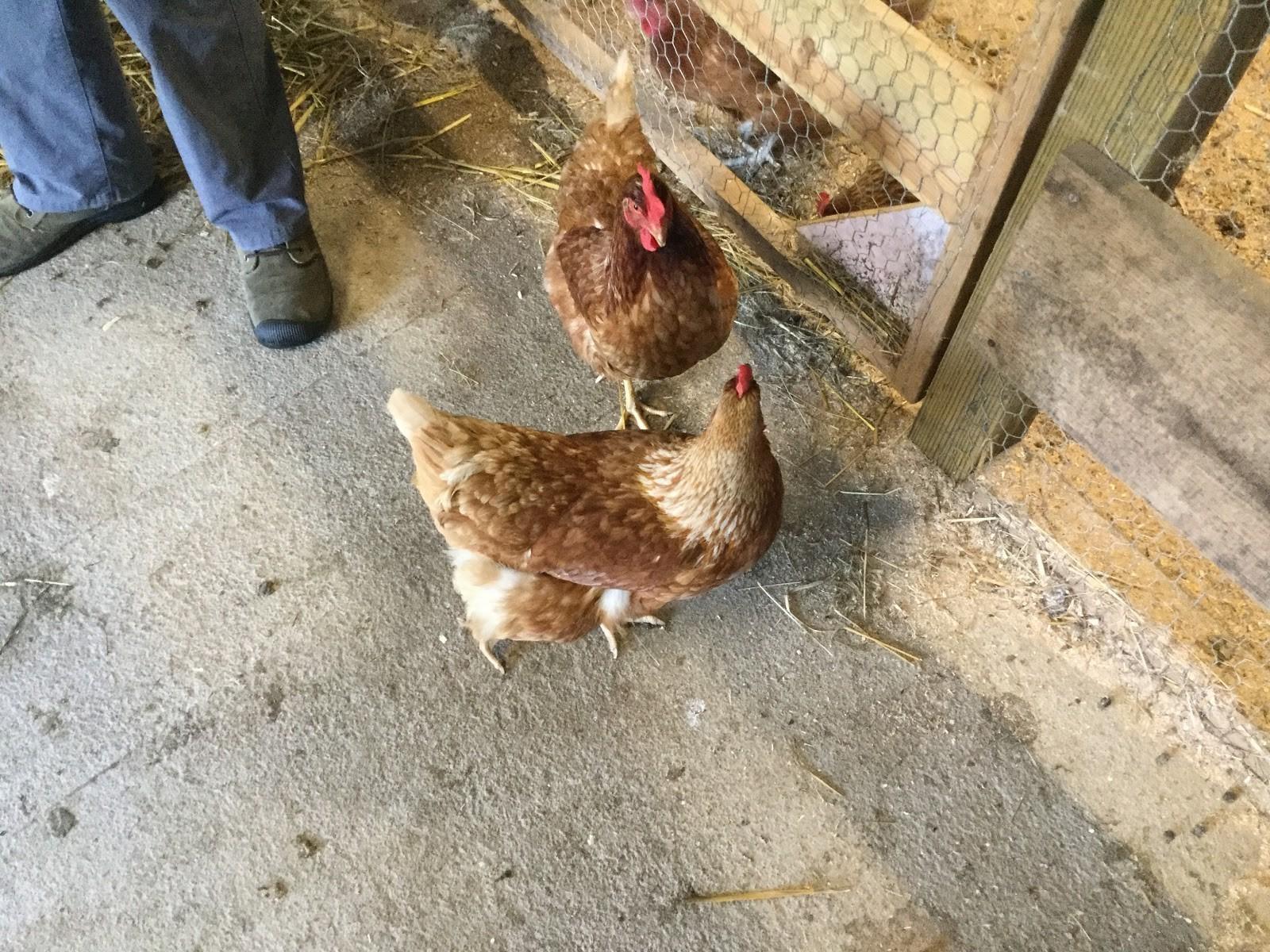
Chicken litter, which includes feces, spilled feed, feathers, and bedding material, can harbor harmful germs. To avoid spreading germs to your garden, do not locate chicken coops close to gardens. Since litter can collect on the soles of shoes, avoid going from chicken coops to gardens. Do not allow chickens to enter the garden or the classrooms. Children should wash their hands before and after any interactions with chickens. This will both protect the chickens from illnesses and prevent the spread of germs from the chickens themselves.
Harvest Your Produce Safely
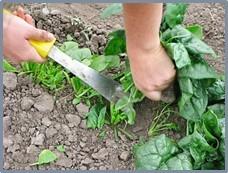
Harvest containers and tools should be easy to clean and sanitize, especially if they are going to be used repeatedly. Wash your hands before and after picking produce. If you use gloves, make sure they are clean. Educate students that gloves are used not only to protect their hands, but also to protect the produce. Remove excess garden soil and/or debris before putting produce into harvest containers. Produce that has fallen onto the ground, also known as “drops,” should not be harvested. Fecal matter, tracks, and chewed leaves are signs of animal intrusion into gardens. Because animals can carry harmful germs, produce displaying these signs should not be harvested. Produce that has fecal matter on it should be removed by the instructor. If animal intrusion is a regular issue, consider establishing a “buffer” distance between fecal matter and produce that you can harvest safely. In general, a minimum distance of 1 foot around the fecal matter is acceptable.
Washing Your Produce Helps Minimize Risk of Harmful Germs
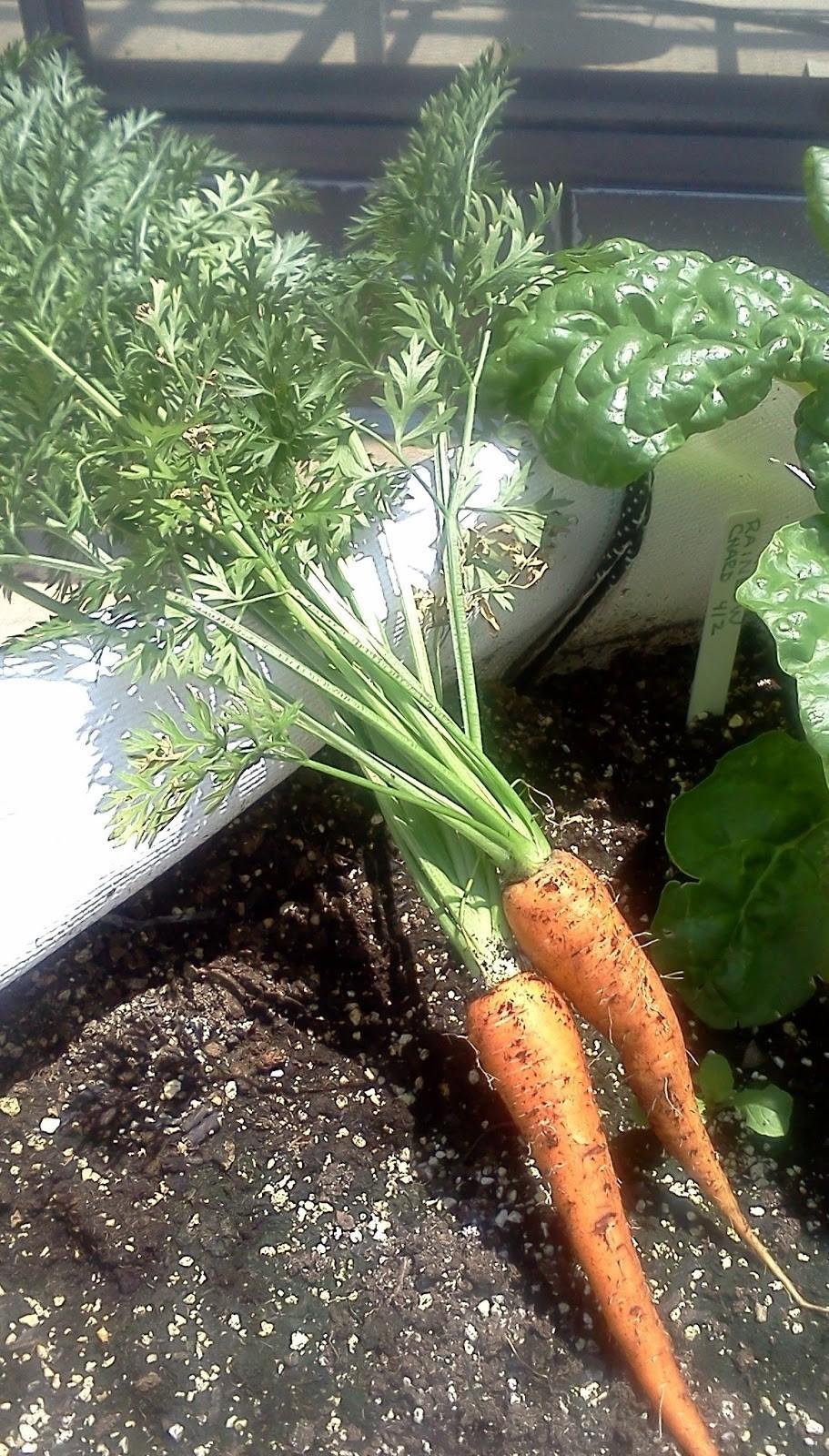
Just like fruits and vegetables, germs need water to live and grow. Therefore, germs are often found wherever there is water. While it is useful for washing soil and other debris off produce and food contact surfaces, water can also serve as a vehicle for the spread of germs. For example, dumping root vegetables into a tank of water may be an efficient way to clean many carrots at once, but it can also pose a risk if there is contamination on any one of the carrots.
Without the use of a sanitizer in the water, it is possible for contamination on one piece of produce to spread to all of the produce in the tank water. Check with the school to determine if teachers can wash produce or if cafeteria personnel should assist. Cleaning and peeling root vegetables such as carrots is a good way to remove soil and reduce the risk of pathogens or heavy metals on the produce. You do not have to wash any produce not eaten immediately after harvest. Wash it prior to eating which reduces moisture on the produce and prevents the growth of mold and bacteria.
You Do Not Have to Refrigerate Produce but Always Store It Carefully
Keep produce stored at room temperature in cool, dry, pest-free, well-ventilated areas away from chemicals. Keep produce bins and lids in the refrigerator clean. Check that your refrigerator is at 40 degrees Fahrenheit or less.
A Food Safety Plan is Optional but Developing one can be a Good Lesson for Students
Keep your school’s garden and/or greenhouse policies in a central location. With photos and an accurate description of the garden/greenhouse, a food safety plan can effectively showcase the garden to parents, school administrators, and other teachers. You can follow the outline of this fact sheet, or any other format to help students prepare a food safety plan. The plan should include a garden/greenhouse map with first aid kit locations (See “Food Safety in Your School Garden and Greenhouse: Resources” https://mda.maryland.gov/farm_to_school/Pages/Food-Safety.aspx).
Schools do not Need a License or Certification to Grow Produce on School Grounds
If your school plans to serve the garden or greenhouse harvest for school lunch, the garden manager should consult with the district’s Food Service Director. If you want verification that your practices are optimal for food safety, the Maryland Department of Agriculture offers a no-cost GAP inspection and certification.
Have A Question? Ask an Expert!
Ask an Expert provides FREE answers to your gardening questions. Staff from University of Maryland Extension’s local and state faculty will answer your questions about gardening, food safety, nutrition, insects, and much more in less than 48 hours. http://extension.umd.edu/ask.
Are Grants Available?
Grants from Kidsgardening.org, the National Gardening Association, and USDA may be available to help schools with resources for school gardens and greenhouses. There may also be local or state grants available. A good starting point is the Maryland Department of Agriculture’s School Gardens and Grants (https://mda.maryland.gov/farm_to_school/Pages/School-Garden-Resources.aspx).
Glossary
Animal intrusion- Wildlife or other animal activity in produce growing and handling areas that leaves observable evidence in the form of animal feces, urine, tracks, or crop damage. Animal intrusion should be evaluated during the growing season and immediately prior to harvest to minimize risks of produce contamination from animal fecal material that may contain human pathogens.
Bacteria- Single-cell microorganisms without distinct nuclei or organized cell structures.
Cleaning- Physical removal of dirt (soil) from surfaces which can include the use of clean water and detergent.
Composting- A process to produce stabilized compost in which organic material is decomposed by the actions of microorganisms under thermophilic conditions for a designated period of time (for example, 3 days) at a designated temperature (for example, 131°F (55 °C)), followed by a curing stage under cooler conditions.
Contamination- The unintended presence of potentially harmful substances in food, including microorganisms, chemicals, and physical objects.
Cross-contamination- Contamination of one food item with microbial pathogens from another food item, water, surface, or other object. Sources of cross-contamination may include pathogens transferred to produce through contaminated wash or irrigation water, improperly applied manure, animal feces, packing lines, worker hands, harvest bins, or trucks.
Curing- The final stage of composting, which is conducted after much of the readily metabolized biological material has been decomposed, at cooler temperatures than those in the thermophilic phase of composting, to further reduce pathogens, promote further decomposition of cellulose and lignin, and stabilize composition. Curing may or may not involve insulation, depending on environmental conditions.
Detergent- A cleaning agent that contains surfactants that reduce surface tension between food surfaces and dirt (soil) or other debris. Detergents aid in lifting dirt off surfaces. Detergents are used in the cleaning process before a sanitizer.
Dropped produce (drops)- Produce that drops to the ground before harvest. Dropped produce does not include root crops that grow underground such as carrots, crops that grow on the ground such as cantaloupe, or produce that is intentionally dropped to the ground as part of harvesting such as almonds. Produce unintentionally dropped to the ground during harvest is also considered dropped covered produce.
Food Safety Plan- A written document that outlines food safety practices and may include recordkeeping logs, Standard Operating Procedures, and other supporting documents that help implement food safety practices.
Good Agricultural Practices (GAPs)- Any agricultural management practice or operational procedure that reduces microbial risks or prevents contamination of fruits and vegetables on the farm or in packing areas.
Green waste- Biodegradable waste that may be composed of garden or farm waste, such as grass, flower cuttings, hedge trimmings, as well as domestic and commercial plant-based food waste. Green waste cannot be considered zero risk since it may contain physical, chemical, or biological hazards. If the green waste contains any materials of animal origin, including animal feces, it cannot be considered green waste.
Hazard- Any biological agent that has the potential to cause illness or injury in the absence of its control.
Heavy metals- Elements including cadmium, lead, and mercury. All are poisonous.
Herbicide- A type of pesticide that kills plants, especially weeds.
Horticulture- The science or art of cultivating fruits, vegetables, flowers, or ornamental plants.
Inorganic fertilizer- A chemical fertilizer of synthetic or mineral origin.
Manure- Animal excreta, alone or in combination with litter (such as straw and feathers used for animal bedding) for use as a soil amendment.
Microorganisms- Microorganisms means yeasts, molds, bacteria, viruses, protozoa, and microscopic parasites and includes species having public health significance. The term ‘‘undesirable microorganisms’’ includes those microorganisms that are of public health significance, that subject food to decomposition, that indicate ood is contaminated with filth, or that otherwise may cause food to be adulterated.
Pathogen- A disease-causing microorganism, or other microorganism of public health significance.
Pest- Any objectionable animal or insect, including birds, rodents, flies, and larvae.
Pesticide- A chemical preparation for destroying plant, fungal, or animal pests.
Potable- Meets the Environmental Protection Agency (EPA) primary drinking water standards, including microbiological quality.
Sanitize- To adequately treat cleaned surfaces by a process that is effective in destroying vegetative cells of microorganisms of public health significance, and in substantially reducing numbers of other undesirable microorganisms, but without adversely affecting the product or its safety for the consumer.
Sanitizer- A substance that reduces the amount of microorganisms to acceptable levels, typically for use on food contact surfaces. Sanitizers are generally considered to be part of a broader group of substances called antimicrobial pesticides. The antimicrobial product label will describe approved uses, such as for water or for food contact surfaces, as well as approved concentrations or dosages.
School gardens- Gardens and/or greenhouses located on school property that are used for nutrition, agriculture, and experiential education across all disciplines. School gardens can span container gardens to more complex systems, such as greenhouses, aquaponics, etc. on school grounds.
Total coliforms, fecal coliforms, and Escherichia coli (E. coli)- Coliforms are bacteria found in the environment, soil and intestines of warm-blooded animals. Fecal coliforms are a type of coliform that are more likely to be specifically associated with human or animal fecal material and are a more accurate indication of the presence of feces than total coliforms. Escherichia coli (E. coli) is within the group of fecal coliforms. Generic E. coli is considered to be the most likely species within the fecal and total coliforms to indicate that the water may contain fecal contamination and is designated as the indicator organism to meet the agricultural water criteria in the Food Safety Modernization Act Produce Safety Rule.
University of Maryland Extension (UME)- A statewide, non-formal education system within the college of Agriculture and Natural Resources and the University of Maryland Eastern Shore. UME educational programs and problem-solving assistance are available to citizens and are based on the research and experience of land grant universities such as the University of Maryland, College Park.
Resources
- Maryland Department of Agriculture. 2010. Integrated Pest Management in Schools – Plant Selection and Care. http://mda.maryland.gov/plants-pests/Document /ipmplant_care.pdf
- U. S. Department of Agriculture Food and Nutrition Service. Food Safety Tips for School Gardens. http://www.fns.usda.gov/sites/default/files/foodsafety_schoolgardens.pdf
- New Jersey Agricultural Experiment Station. 2013. Rain Barrels Part IV:Testing and Applying Harvested Water to Irrigate a Vegetable Garden.https://njaes.rutgers.edu/pubs./fs1218/
- N.C. A & T State University Cooperative Extension. Food Safety for School and Community Gardens: A Handbook for Beginning and Veteran Garden Organizers: How to Reduce Food Safety Risks. https://chapmanfoodsafety.files.wordpress.com/2011/08/food-safety-for-school-and-community-gardens.pdf
- U.S. Food and Drug Administration. 1998. Guide to Minimize Microbial Food Safety Hazards for Fresh Fruits and Vegetables. https://www.fda.gov/downloads/Food/GuidanceRegulation/UCM169112.pdf
- State of Maryland HB0270. Environment - Testing for Lead in Drinking Water - Public and Nonpublic Schools. http://mgaleg.maryland.gov/webmga/frmMain.aspx?pid=billpage&stab=01&id=hb0270&tab=subject3&ys=2017RS
- University of Maryland Food Safety Nutrition Education. Garden Planning Checklist. https://eatsmart.umd.edu/sites/eatsmart.umd.edu/files/Garden%20Checklist.pdf
Adapted from:
- University of Maryland Extension. 2011. Food Safety in the School Garden.http://extension.umd.edu/sites/default/files/_images/programs/hgic/Publications/GE005_Food_Safety_in_School_Garden.pdf (replaced by this factsheet)
- Produce Safety Alliance. Grower Training Course, Version 1.0, 2016
JUSTINE BEAULIEU
HEATHER BURITSCH
buritsch@umd.edu
SHAUNA HENLEY
shenley@umd.edu
JON TRAUNFELD
jont@umd.edu
This publication, Food Safety in Your School Gardens, Classrooms, and Greenhouses (FS-1077) is a part of a collection produced by the University of Maryland Extension within the College of Agriculture and Natural Resources.
The information presented has met UME peer-review standards, including internal and external technical review. For help accessing this or any UME publication contact: itaccessibility@umd.edu
For more information on this and other topics, visit the University of Maryland Extension website at extension.umd.edu
University programs, activities, and facilities are available to all without regard to race, color, sex, gender identity or expression, sexual orientation, marital status, age, national origin, political affiliation, physical or mental disability, religion, protected veteran status, genetic information, personal appearance, or any other legally protected class.